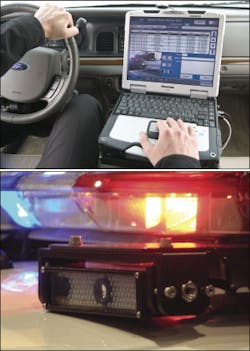Plate spotting
Steven Hedley says he didn't even see the truck that night.
It was pitch black, and he and his partner were two among a few hundred officers spread throughout the City of Atlanta, patrolling as part of a detail night with the Atlanta Police Department in Georgia. The pair was on their way to a road block when an electronic beep registered a passing vehicle tag as a law enforcement-flagged plate.
The truck, indicated as a car-jacked vehicle, was carrying five passengers, though Hedley and his partner, Ilka Torres, didn't know it at the time.
"You never know what that car that you're passing is wanted for," Hedley says. "If I did not have the LPR that night, I can only imagine, knowing what I know now, what could have happened to those girls."
The technology at work
ELSAG's license plate reader system doesn't just read automated plates; its name declares it "hunts" them.
Some license plate reader (LPR) proponents would go further to personify the technology as an officer itself, constantly surveying for tags, but removed from human elements like fatigue and distraction. It sure beat the manual survey and hard-copy hotlist reference method Hedley and the Atlanta Auto Theft Task Force was used too.
The new system, the Mobile Plate Hunter-900 from ELSAG North America, uses infrared cameras, which scan for and capture images of characters on plates. The processing unit and software reference the information collected by the camera against preloaded hotlists and sends automatic alerts when flagged plates are recognized.
"It all starts with the all-seeing eye: That officer on the back of the car that never stops looking and [has] the ability of running dozens and dozens of tags every minute," says Hedley.
Once the LPR unit identifies a vehicle of interest, officers take the technical element out of it and implement the human element, rerunning the registration and making sure the vehicle is still of interest; still listed as stolen, for example.
In October 2006, when the LPR unit alerted Hedley and his partner to the hot vehicle, Hedley was still testing the technology out. The equipment was provided by ELSAG North America on a trial basis for the officers to familiarize themselves with, and for command staff to collect data on the technology in order to secure funding to purchase an ELSAG system. What was originally a 30-day trial turned into a five-month loan. Bean counters needed to see the value of the technology in order to be persuaded the $25,000 piece of equipment was in the budget. And part of that proof came as the night unfolded on October 12, 2006.
Hedley didn't know there were three girls in the passenger compartment of the truck's cab. What's of greater urgency was what he didn't know about the driver and front passenger.
After a 30-mile pursuit, which covered an interstate roadway and ended in a gated community, two guns were recovered, one later confirmed as a stolen firearm from a neighboring jurisdiction. The driver was captured after a foot chase through an apartment building - a murder suspect out on bond. The passenger was apprehended immediately after the truck had crashed into a tree - he was a sex offender, convicted of rape, who had just been released on bond from prison.
The three juvenile females between 15 and 16 years old, held against their will in the quad-cab portion of the rogue truck, survived the incident unharmed.
Other offerings
Show Low, Arizona, acts as the tourism and shopping hub in the Northeastern corner of Arizona. Its year-round population is approximately 12,400, but due to its commercial center, regional medical facility, and its unique geography as a crossway for three states and U.S. highways, Chief Jeffrey Smythe says the police department serves a population closer to several times that base count.
In order to combat the unique policing challenges in the City of Show Low, Smythe has been working with Phoenix-based Redflex over the past year to implement a combination photo enforcement and automated license plate recognition (ALPR) technology package, which integrates PlateScan Inc.'s unit. Smythe has contracted Redflex to integrate several fixed sites in the city to act as both a surveillance strategy and a real-time notification system for hotlisted vehicle tags.
Two cameras are planned to monitor incoming traffic from the Phoenix area. "What we're looking forward to is being able to interdict stolen cars and drug offenders as they enter our community and arrest them prior to landing here in Show Low, so to speak," Smythe says.
Show Low was able to secure funding for the license plate recognition systems because it is blending PlateScan technology with Redflex's red light and speed enforcement system, enabling the city to use violater fines to pay for the package, Smythe explains. "I have a fairly small department with a fairly tight budget, so to be able to go out and spend $25,000 or $30,000 on a plate scan system - I certainly can't afford to do that," Smythe says. In the end, he says the several sites, with two planned to be running as early as May, will end up costing the department little or nothing.
Florida-based NDI Technologies offers its next generation ALPR system, VeriPlate. Originally launched in 2006, VeriPlate has added features like automatic wireless hotlist transmission, in-car mapping, CAD system integration, among others in the last three years. Keith Yahn, operations manager for NDI for six years, explains VeriPlate is also able to validate tag alarms live through its control center and the in-vehicle CAD with a single button push.
Tech hurdles
A variety of obstacles litter the path between LPR technology and widespread successful implementation.
One hurdle that has been consistently brought up over time is a concern over privacy. Accusations of LPR units as a Big Brother-like surveillance can generally be counted on to appear in LPR articles written for consumers. Later this year, the International Association of Chiefs of Police plans to complete two projects addressing these LPR privacy issues and policy execution. A spokeswoman for the initiatives explains a Privacy Impact Assessment and Policy and Operational Guide should ensure data is managed to meet the needs of public safety while protecting individuals' privacy interests.
Other challenges in tag reading are rooted in the variety of plates on the road in the Unites States.
Charlie Carpinteri, director of product development for Redflex Traffic Systems, explains the inconsistent appearances of plates from state to state make recognition tricky.
"You have multiple different plates, fonts, designs, combinations of characters and you have color to deal with," says Carpinteri, who has worked with Redflex for 10 years. "Then there are sort of static decorative images … that are nightmares for machine vision." The technology utilized in Redflex's ALPR systems tackles this problem through what Carpinteri calls an artificial intelligence approach. Neural network algorithms (as opposed to more common optical character recognition algorithms) identify characters by pointing at them from different angles, which Carpinteri says results in more accurate reads and can do a better job of identifying characters obscured by dirt or snow.
Today's potential
"The very first day we were out, my partner and I recovered two stolen vehicles," Hedley says. "We thought, wow, this is going to make our jobs 10 times easier, it's a much more efficient use of manpower and the technology can only get better."
And it has.
LPR systems today incorporate other law enforcement resources into their offerings.
Mark Windover, CEO and founder of ELSAG, says since the company's inception, the ability to integrate child abduction bulletins, such as AMBER Alerts, was an important consideration. Windover explains there are a variety of ways police can utilize information known about a vehicle in an abduction, such as referencing partial plate information on LPR patrol and reviewing any recent tag read history for leads.
An officer entering a new plate to the hotlist will be prompted by the system to search previous reads and can find that, for example, that vehicle was read by the LPR system 20 minutes ago in a Wal-Mart parking lot. "Now you know where to begin your search," Windover says.
Officers can also check a partial plate off all the previous reads throughout the organization, which for agencies such as the New York Police Department, Windover explains can look back at millions of tag records.
Windover says MPH-900 can be utilized to enforce geographic restrictions placed in protective order and sex offender cases.
This capability, called geofencing, allows police to program geographic coordinates for areas such as school zones, parks or daycare facilities, and can alert officers off a registered sexual offender hotlist, should one of those vehicles be spotted in a restricted zone. The same principle applies to protective orders. For example, if an order prohibits a person from being near his or her ex-spouse or a child, police can input the location of areas so the restricted car triggers an alert when read by an LPR unit near the protected's work, home or the child's daycare.
"We can cross match [databases] to sexual predators and basically create radiuses around schools, parks, baseball fields, daycares," Windover explains. "[Whenever] the subgroup of license plates - the registered sexual offenders - are encountered in that area, the alarm will go off."
The information collected by MPH-900, including color images of the license plate, back of the car, date and time stamps and GPS coordinates, can be stored for analysis or future reference. ELSAG touts a 2008 case in which a man was convicted of a mass murder and arson in Fishkill, New York, in part thanks to an LPR picture that was able to discredit the defendant's alibi and instead, placed him near the crime scene in the window of time the crime reportedly took place.
Measuring the value of LPR
Turning the LPR pictures into data in microseconds puts useful information into officers' hands far more quickly that yesterday's manual methods.
In Hedley's 2006 career-changing experience, he says it was all to the LPR unit's credit that the truck was identified; the driver was not speeding and there were no other obvious indicators that something was amiss.
Windover affirms, "Our equipment can tell [officers] whether or not there's a bad guy right next to him in milliseconds."
Reading about hot technology is one thing, but pulling three girls, held against their will, from the stolen truck vetted the utility of this technology for Hedley. He retired from Atlanta PD last February and joined ELSAG, demonstrating the system and training officers on its use.
He pauses when reflecting what could have been had the fugitive wanted for murder and the paroled registered sex offender not been intercepted that evening.
"We could have prevented a rape, possibly a murder - there's no telling. I mean, there were two armed, dangerous fugitives, both of them with a gun, and there were three innocent juvenile females in the back of the car," he explains. "If it wasn't for the LPR, we would have just passed it and he would have kept going."
As Hedley suggests, there are three girls from Atlanta who would likely say the value of LPR technology is immeasurable.

Tabatha Wethal | Editor
Award-winning writer Tabatha Wethal is a previous editor leading Law Enforcement Technology magazine and assisted with other publications. She was with the magazines since 2007.



